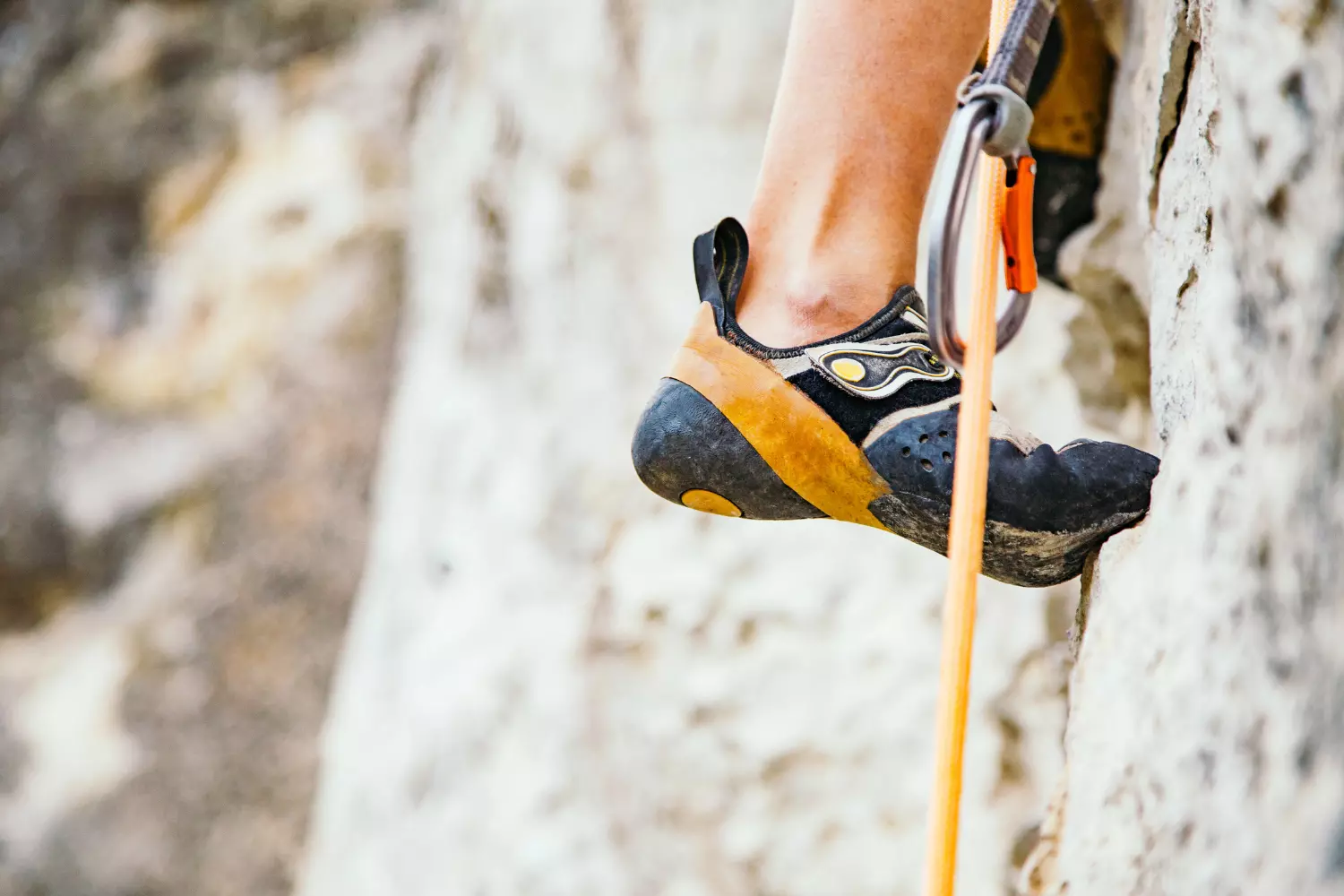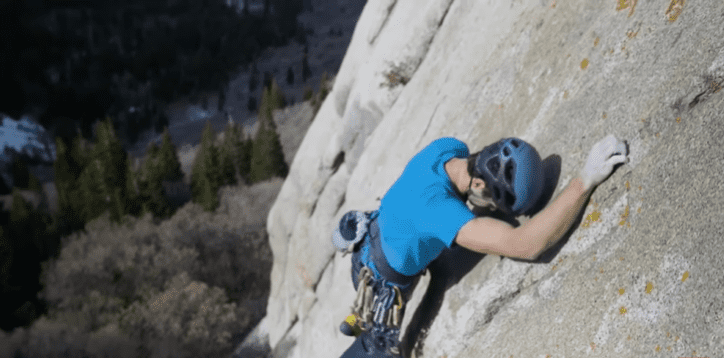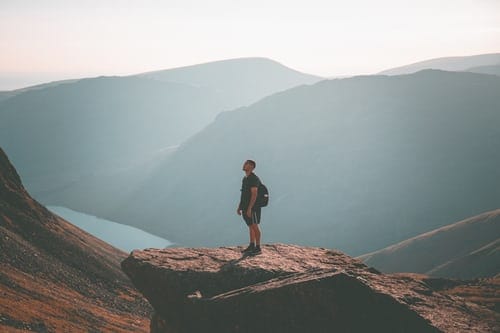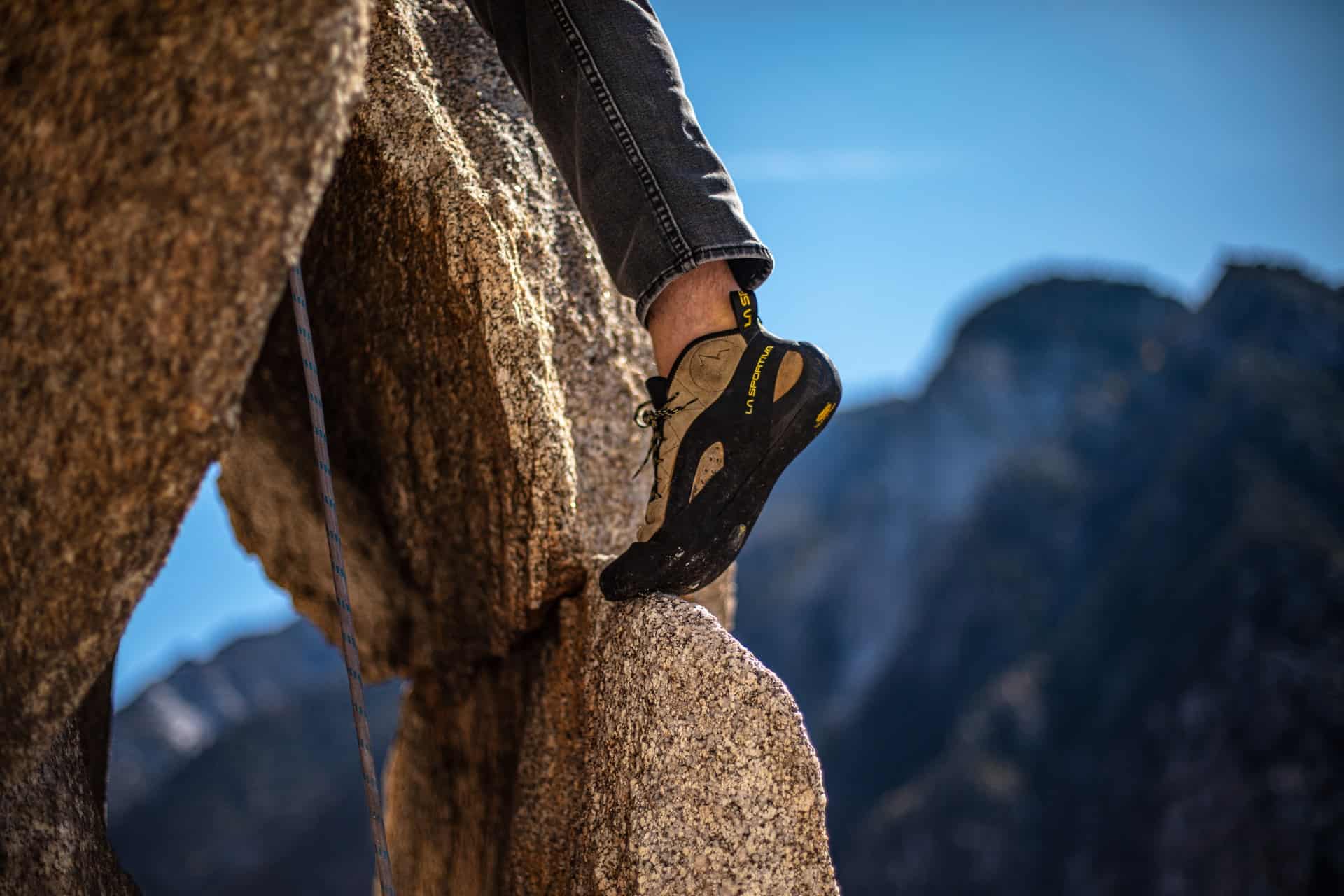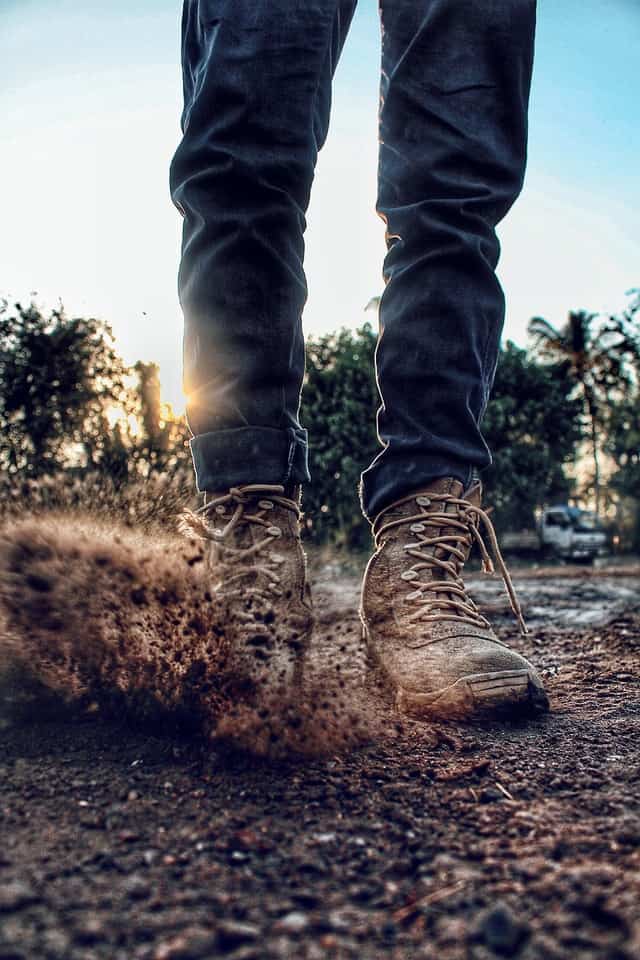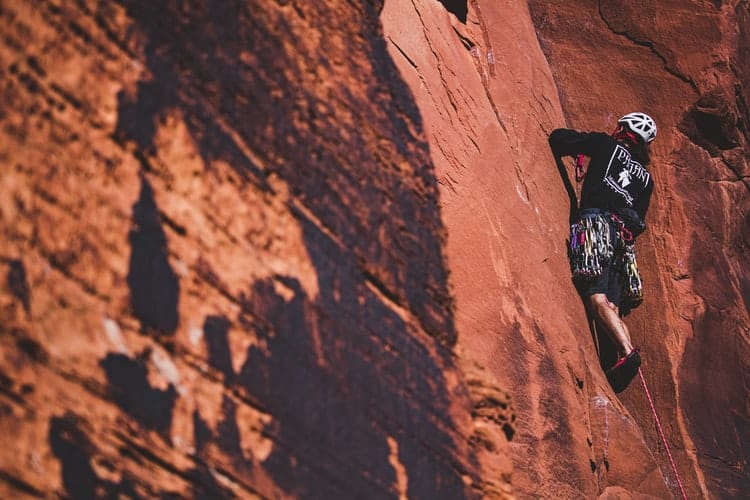To be a good climber you must be physically strong and resilient, have good technique, and be mentally efficient. While most books and videos deal with the first two aspects, far fewer authors deal with the psychological one. This article is about mental training for climbing, covering the most important aspects.
Among climbers who decide to train to progress, the usual thing is to work on strength, power, resistance, or, some even, technique. But who trains the psychological aspect?
You train once a day and eat 3 to 5 times, but the number of daily thoughts is around 60,000. Most are redundant and/or negative.
Among elite athletes, whose physical abilities differ only slightly, mental strength is often the determining factor for success. But the weekend recreational climber is unaware of the potential he is missing out on by not working “the psyche or the bogeyman.”
The biggest barriers to progression as a climber may be psychological, unconsciously self-imposed.

EMOTIONAL COACHING STRATEGIES
In activities such as climbing, it is normal to feel on a roller coaster of emotions. You are happy while chaining a route when suddenly you come to a section that you do not know how to solve. Your forearms are congested and the strength is diluted.
Falling victim to tension and stress will result in a reduced field of vision, making it difficult to find the best solution. The first thing you should do is recognize those situations and the emotions that arise. The next thing will be to be aware and try to control them through practice.
As the Stoic Epictetus said: “It is our attitude towards events, not the events themselves that we can control.” Without a doubt, one of the most useful learnings for day-to-day (you have more in the article on stoicism).
There are some techniques that you can introduce as part of the training that will help you manage such emotions:
SELF-CONTROL
Being able to control your mind is a real superpower. As Arno Ilgner points out, thoughts external to the climb you’re making are power leaks. That is, like holes in an inflatable boat through which the air escapes.
You don’t lose your skills because of a distraction; what you lose is the focus that allows you to carry them out effectively (Olrick, 2003). This ability to focus is one of the most common qualities in elite athletes.
Control your emotions or they will control you. Uncontrolled negative emotions are destructive. The sooner you learn to get away from such negative thoughts, the sooner you will take control of your climb and your life.
Elite athletes experience setbacks, fatigue, fear, stress, and self-doubt just like anyone else. However, they have developed skills to let go of negative thoughts and focus on positive ones.
Whether it’s the noise at the foot of the track, a work matter, or an argument with a family member, not being able to disconnect from those thoughts will weaken you as a climber.
In this aspect, it is advisable to keep the mobile phone turned off or in airplane mode in the sector. If you can’t, at least put it on silent. These mechanisms end up being doors that connect the problems with the fantastic place that you are not enjoying.
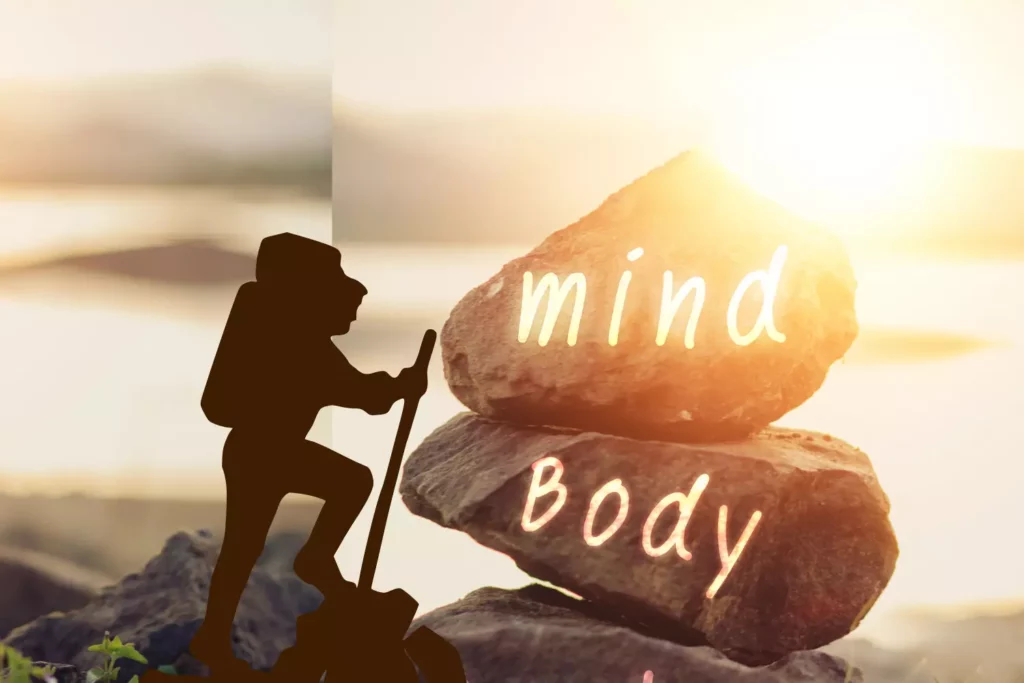
LEVEL OF ACTIVATION/EXCITATION (AROUSAL)
Adopting the correct level of arousal is also a trainable habit. In the physical steps of strength, you will need greater arousal. However, in sections of the thin adherent plates, it is better not to climb too excitedly.
These levels of greater or lesser activation will alternate and you will have to learn to adapt it to each route; as it happens with the ideal rhythm of climbing.
Hard climbing and relaxation may seem like contradictory concepts at first. However, many of the best sports performances happen when the participants are loose and relaxed in the process.
With too much muscle tension, energy expenditure is higher, which will accelerate fatigue. But in addition, the neural pathways are occupied by sudden and imprecise impulses. This complicates the execution of movements that require coordination and delicacy.
Surely you have felt that sensation climbing thin plates with distances between the safeties. In those moments, either you manage to relax or you will not be able to climb “fine”.
But it also reduces the field of vision, causing what is known as “tunnel vision.” You will be familiar with the moment when, after falling on a sight route, you discover a dam or an alternative sequence that you had not seen in the hit.
Also, climbing with fear or stress triggers the production of catecholamines and norepinephrine. This state will make you expend more energy, generating great fatigue.
However, a certain level of arousal can be considered positive. Feeling alert and focused, with your body ready for action, makes you feel alive.
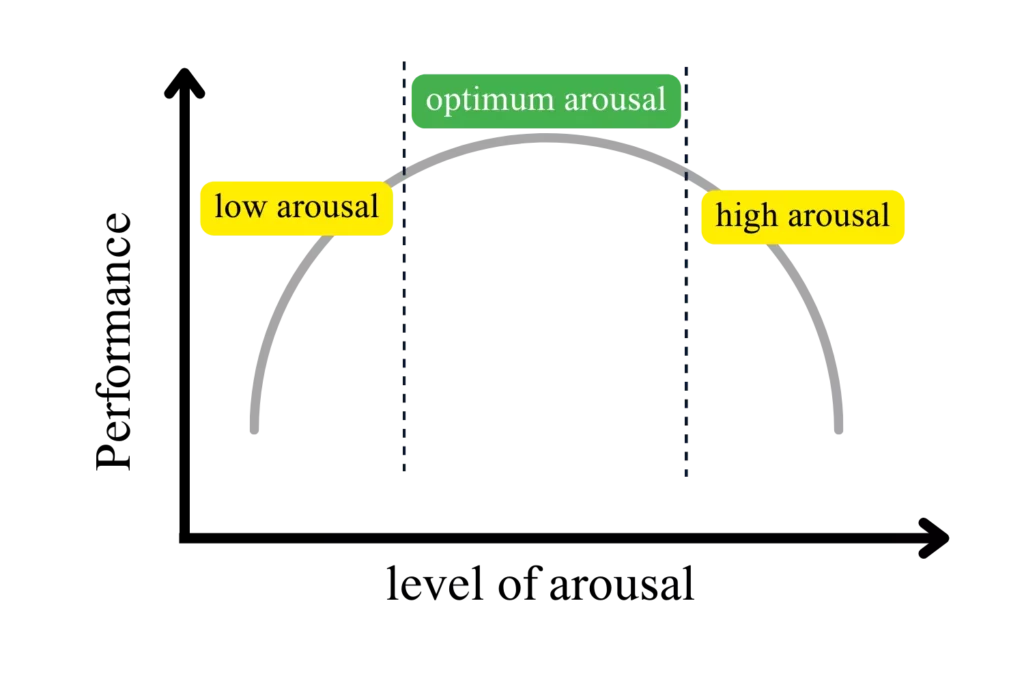
BE OOBLECK
Bruce Lee said, “be water, my friend”. However, German coach Udo Neumann points out that a climber must be Oobleck. It is a non-Newtonian fluid that changes between solid and liquid according to the force received.
The climber’s adaptability to the route is important performance quality. This adaptability must occur both at a spatial level (performing the movements) and temporally(rhythm) and mentally(arousal).
Justen Sjong indicates that adjusting arousal levels is like contracting a muscle. Just like you work your muscles in workouts, do the same with arousal control.
Some tools to adjust « arousal » are:
ANXIETY
On occasions such as a competition, the last hits of a trip, or an overworked project that excitement turns into anxiety. It is a state that will affect you negatively, even at the somatic level: sweating, tremors, tunnel vision, inaccuracy, and clumsiness when climbing,…
Processing Efficiency Theory states that if you are anxious, you will devote storage and processing resources to that concern. By reducing your attention span, your performance could worsen (learn more in the Climbing Anxiety article).
What do you feel when you start to get tense? Become aware of these signs when they begin to surface.
The reason for this anxiety is usually the interpretation you make of future events. You can also rely on past performance. Be that as it may, as Mark Twain pointed out: “Most of the problems I’ve experienced in my life, never happened.”
In these situations, try to be aware and relativize the importance of the event. After all, what does one more route mean in your notebook? In a competition, it is better to detach yourself from the result and focus on the process.
Escalation goes hand in hand with uncertainty. It takes place in a complex environment, beyond your control. That anxiety about the result increases the greater the gap between the perceived abilities and the challenge. In the case of fear of falling, that binomial is between the exposure to the route and your ability to climb it.
Getting away from self-evaluation and worries will make you feel less anxious. Focusing on executing the next move or what you’re enjoying on that route reduces tension.
One way to combat anxiety over a hit is to delay it. The previous day’s visualization works. As the moment approaches, start thinking about what you are doing: now I am having breakfast.; right now I focus on driving; I get to the sector, I tie my knot, I put on my climbing shoes… and that’s it, well, there’s no other choice but to climb. And when you climb, focus on each movement you make.
There is no single way to relax. You should find the one that works best for you.
CONTROL THE NERVES
Getting nervous is normal. It makes you feel alive. However, you can interpret this state in different ways:
FEAR TO FAIL
In climbing, there are many types of fears. Some are rational and justified. Others are irrational and may be caused by the uncertainty of the outcome of an action.
One of the most engaging aspects of climbing is the variety. Being able to travel and climb different itineraries, while getting to know new places, is part of its essence. However, this quality is linked to uncertainty.
Fear of falling is very common among climbers. Although it has an evolutionary justification, it does not have to be rational (real, objective). This is a subject that goes a long way, and if you are interested in going deeper, I recommend you read the article on managing the fear of falling in climbing.
This time, it’s about the fear of failure. That concern about failing makes many climbers not even try. It may be for not looking bad in front of the troops; or, simply, for not failing himself.
UNDERSTANDING FAILURE AS LEARNING
To progress in your career as a climber you must eliminate the word failure from your vocabulary. Change it to learning or lesson. And it is that you must assume that you will never stop being an apprentice climber.
Not even the best climbers in the world stop learning. Having a healthy appetite for a continuous improvement mindset and always open to new ideas, they have become expert problem solvers. They have managed to feel comfortable in uncertainty.
A defeat can serve to broaden your perspectives or redirect your path, both in sports and in life. Failure is unpleasant at first. However, it will teach you how to better prepare yourself for future difficult situations. If you manage to get something positive out of your falls by looking at them with perspective, you will not feel frustrated.
Constructive reaction to mistakes or imperfections is a skill that you can learn. Most people react by becoming angry with themselves and others, or by becoming depressed.
So, if even the best climbers have assumed the role of continuous learning, what is the problem in not chaining, falling, or not seeing a step? It is part of the way.
When you’re climbing a route and the pressure gets to you, relativize. Zoom out and think about what that route will mean in your life as a climber. If it doesn’t come out now, it will come out. And if not, what else? In the end, it will be one more route of the hundreds (or thousands) that you climb. One more milestone is on the way.
But even the best climbers are human. And as such, imperfect beings must deal with their emotions. A sample is a film Rotpunkt, in which Alex Megos shows his human character in front of the camera.
POST ANALYSIS
Analyze the failure afterward to learn and avoid it in the future. Why have you fallen off the road? Did you get nervous? Were you afraid and did you climb tensely, over-tightening the holds? A distraction? Were you tired because in the easy part you messed with your feet and spent more energy? Once you figure it out, think of a plan for the next time it happens.
It is important that you carry out this analysis as soon as possible after the performance. That way, you’ll remember as many details as possible.
FRUSTRATION WITH SOCIAL COMPARISON
The human being is a social being that preserves ancestral behaviors in a technological society. One of them is the need to be accepted by the community, since generations ago exclusion meant death.
Similarly, the tendency to compare oneself with others and be concerned about “what they will think” or “what they will say” is common. This feeling can get frustrating and make you not try the route or boulder you want simply because there are more people trying it.
To overcome this frustration, simply put yourself in the other place. What do you think when a climber is trying a project that is hard for him? Most of the time, you won’t even pay attention to it. And others, you will encourage him if you see him struggling. It may even motivate you. So why are you scared of what they might think of you?
However, you can turn the tables, taking advantage of that social aspect to come up with the warmth of the public or the encouragement of your colleagues.
HOW TO WORK THE FOCUS
Evolutionarily, the brain is made to be distracted. This facility to go towards any distraction in the environment has allowed man to survive in dangerous areas, inhabited by predators.
However, in today’s society, the opposite is rewarded. A strong mind is considered to be one capable of overcoming distractions. This way, you can get more out of your time. And that time, which cannot be recovered, will ultimately be your life.
Fully directed attention frees you from the irrelevant and connects you to your task. Distractions can be external (from the environment) or internal (your thoughts).
In competitive athletes, staying focused despite distractions is probably the most important skill of all to perform consistently and reach your full potential in competition. It is a skill that takes a lot of practice to perfect.
The practice of meditation has shown multiple benefits supported by scientific studies. Its practice is increasingly common in this society where a multitude of stimuli competes for your attention.
Start practicing it in short sessions, with a focus on the breath. Don’t try to make your mind go blank. Simply be aware of when an external stimulus or thought goes. Using the metaphor of John Hargrave in “Mind Hacking”,” attention is like a puppy you take for a walk on a leash. From time to time it will wander away and you will have to bring it back.
Once you are able to stay focused, you can increase the difficulty. One option is for a person to talk to you and try to distract you, while you try not to ramble. It can also help to turn on the television or radio and try to get into a state of mind where you are able to ignore it.
CLIMBING ATTENTION TRAINING
But you also have to work on it specifically. Maintaining attention during a long resistance sequence is not easy, and it is an aspect to train as important as physical fitness.
When climbing, when you feel tired, try a change of focus. Instead of thinking about how tired you are, focus on technical or task aspects (you can recite the movements) or on words that inject energy (“come on”, “to death”, “a little more”…).
You can also recall a past moment when you emerged victorious from a similar situation. Or even how bad you’ll feel later if you haven’t fought through it all.
TYPES OF CONCENTRATION/ATTENTION
Sports psychology usually distinguishes between:
Climbing you will have to alternate between internal or external attention according to the moment. While moving by sight climbing, it is normal to be centered on the route. But when you come to rest, breathing calmly and focusing on the sensations will help you relax.
External attention will also be different when climbing a project (narrower, as you already know the movements) or on sight (wide enough not to lose details or hidden prey).
Whatever method works for you, remember it so you can use it again next time.
ONE THOUGHT AT A TIME
Attention is limited, with the brain capable of having only one thought at a time. It is up to you to direct that thought towards something useful and positive.
You can’t be worried while you’re thinking about something else, like how good the route you’re climbing is or how cool the breeze is on your skin.
When you climb a route with a hard step near the end, don’t climb the entire route thinking about that move. That will cause you to fail another sequence.
At rest, practice inner attention. Visualize the blood entering and the waste products leaving your muscles. Repeat relaxation words to yourself while you control your breathing and relax the muscles that are not working.
When you start to feel recovered, remember everything you have prepared for that moment. You are strong and you are prepared for what comes to you.
So, switch to an external focus and focus back on the climb. When you feel ready, go back to the attack with everything.
ENTER THE FLOW ZONE
Climbing without thinking is what is known as being in the zone. It is a state where you just flow down the wall, feeling weightless. It only matters what you have in front of you and the present moment. The rest disappears.
The best climbs take place when the mind and muscles come together in harmony.
The flow state is reached when there is a balance between the climber’s skills and the challenge of the route. In addition, he must be able to focus on the activity, avoiding distractions.
It is a magical state, characteristic of the best performances. To dig deeper, you have the article that is about the state of flow in climbing.
PRACTICE ON THE ROCK
The more hours and meters you accumulate on the rock, the more resources you will gain, feeling more comfortable.
Rock climbing takes place in a natural environment, which is beyond human control. This increases the uncertainty.
The more hours and meters you accumulate in this medium, the more calloused both your brain and fingers will have. You will gain resources and feel more comfortable.
Practice positive self-talk. Get used to climbing by opening the routes (first) and try to figure out the steps yourself. And when you fall, enjoy the moment.
Trust the material you use and your climbing partner. Surround yourself with positive people. Run away from those who only focus on the negative side of events.
CHANGE, CHANCE, AND UNCERTAINTY
If you don’t leave your local school, your comfort zone will be reduced. When visiting other walls, your mind will send you messages of discomfort due to uncertainty.
However, if you do it on a regular basis, you will accumulate a lot of baggage that will give you more resources. Climbing takes place in a variable environment. The more variety of schools you know and climbing styles, you practice, the more resources you will have compared to what you can find. As a result, your mind will feel more comfortable in each new zone, allowing you to climb more relaxed and natural.
ROUTINES AND RITUALS
Many athletes have rituals. A well-known case is that of the tennis player Rafa Nadal, whose hobbies include ordering the drink bottles, a sequence of gestures in each service, not stepping on the lines of the court in addition to aligning his chair with them, drying the sweat in the same order or drink each gel pack in exactly 4 sips.
When asked the reason for these habits, Rafa points out that doing everything the same way helps him not to get distracted.
While the rituals have a more superstitious aura, the routines are often performance-driven. Most athletes always do the same warm-up, both in training and in competition. It is a way of knowing how they are while helping them feel in a more familiar environment.
After each day of climbing, focus on the positive part. Climbers like Chris Sharma or Adam Ondra have faced projects in which they spent weeks without a measurable progression. Adam Ondra notes that it served him well to focus on long-term evolution while working on “Silence”, the first 9c. In an interview, Chris Sharma pointed out the importance of valuing small advances.
A new hold for the foot, a rest, or a different method. Whatever it is, they will be bringing you closer to your goal.
SELF-CONFIDENCE
High self-confidence, low competition anxiety, being able to focus on the task at hand, the ability to overcome “unexpected” poor performance and positive thinking are qualities of successful athletes (Van den Auwelee et al., 1993).
Self-confidence is earned through the work done and the results achieved. Sticking to the set plan will improve your perceived self-efficacy.
For that process, it is a great power to be able to file the positive memories and discard the negative ones. Jerry Moffatt highlights that quality in great climbers, and that you have to work on it.
But self-talk is also very important. Self-talk is a “dialogue in which the individual interprets feelings and perceptions, regulates and changes evaluations and beliefs, and gives himself instructions and reinforcements” (Hardy et al., 2001).
How you direct yourself, in a positive way and with faith in the results, is the key to success. In sports psychology, positive self-talk is very important.
Eliud Kipgoche already saw himself crossing the finish line of the marathon in less than two hours before achieving it (leaving controversies aside). Adam Ondra dedicated part of his daily training to mental and motor imagery training to get to the “Silence, 9c” chain.
Change “I can’t” to “I’ll get it.” Punishing yourself with bad words when you fail will lower your self-esteem. Instead, convince yourself that you’re up for it.
During the climbing day, repeat yourself over and over again. I’m fine! I’m maxed out! Ready to give my best! As you repeat these positive thoughts to yourself, visualize them. Feel it. Believe in it and do it.
AUTOSUGGESTION
The brain is receptive to any strong and repeated suggestion. This is what is known as “autosuggestion”; and based on repeating these types of positive messages throughout the day; you will get your brain to see itself as capable of doing it. An example is “Mohammad Ali”, who said to himself for years the phrase “I am the best” until he managed to be.
If you are not able to see yourself successfully, you will be creating a self-fulfilling prophecy. The visualization of success is part of the process to achieve it. On this occasion, the correct expression is “if I don’t believe it, I don’t see it”. It allows you to prepare and practice effective responses in your mind before facing a challenge or problem in reality. It is also useful after the day, to recreate and analyze the «performances». You have an entire article dedicated to visualization in climbing.
In the study by Stone et al. (2012), nine cyclists were challenged to compete against themselves. However, they were tricked by increasing the power of the first test by 2%. As a result, the participants performed the test better than the first time.
It is an example of brain power through the placebo effect based on anchoring bias. If you think you were able to do it once, it will be easier for you to do it a second time.
Another example of autosuggestion is the study by Park et al. (2020). In it, the participants were tricked into consuming the same drink but with a different label. One day was labeled as high sugar and another as low. The results show how blood glucose levels acted according to expectations and not reality.
Another example of mind control over your predisposition against what you do. It can be the same task, food, drink…, which depending on how you consider it, will generate a different reaction.
HOW TO DEAL WITH PROBLEMS
Sometimes, unforeseen events or obstacles to your plans will happen. How to deal with them will depend on each specific situation:
Being able to recognize the best posture in each situation will help you keep anxiety at bay.
It is conspicuous how Akiyo Noguchi always smiles when he falls trying a bouldering problem. It is noted that the Japanese climber enjoys the learning process. In the following video you can see how, after some first failed attempts, Akiyo finally understands the movement and comes up, even before having put it into practice.
PERFECTION DOES NOT EXIST
It is common to see videos of climbers chaining routes as if they were floating. What you don’t see there is all the work behind it. But, in addition, in most cases, it is about hits made for the video, recorded in parts so that the shots are beautiful.
This causes that at the minimum failure climbing, you throw in the towel. Well, it turns out that reality is not so idyllic. Feet slip, dams break, and the wrong sequences can be unclimbed, and try another option…
Count on those unforeseen events before they happen and assess how you will react. Few climbers can fight an onsight hit once they’ve messed up a sequence. Being able to do this will help increase your mental strength.
The toxic thoughts you have after a mistake are the ones that program you to fail again. However, just because you make a mistake at the beginning of the route does not mean that you cannot correct it and achieve the chain. Even a bad warm-up won’t mean throwing away your climbing day.
You can’t bemoan how you missed your last hit and have a good performance at the same time. You have to clear your mind of negative thoughts about what has happened and worries about what may happen.
Even if you aspire to do your best, don’t give up if it doesn’t come out perfect. Sometimes, even, you have hit a project so many times that the chain is so perfect that it lacks emotion.
UNLEASH YOUR POTENTIAL
Terry Olrick indicates that every human being has an incredible power within them that is activated in life or death situations. Some examples are typical news stories about people who have performed incredible feats in desperate situations.
It is as if, in such situations, reason stops allowing you to unleash your potential. In sports science terms, it is what makes the difference between absolute strength and maximal strength, which is usually voluntary.
Good mental control will allow you to be a little closer to that inner potential.
FINAL WORDS
In the climbing wall, it is common to see climbers training suspensions, campus board, foot technique, weighted pull-ups… but who trains the mental aspect? How much damage Descartes did do with the mind/body separation?
Take it as something that occurs step by step, day by day, and persists. During the mental training process, you will have ups and downs, just like physical training. Sometimes you will feel mentally strong and in total control; other times, however, you may regress and fall back on unconstructive thoughts, which can frustrate you. But sticking to the plan will improve your perceived self-efficacy and self-esteem.
Anxiety affects your scaling performance, as you will be devoting storage and processing resources to that concern (learn more in the article on scaling anxiety). Learning to deal with it will be part of your path to mastery. With perseverance, you will be able to focus and control your mind for longer and longer periods.
Climbing provides wonderful opportunities to get to know yourself. You can listen to your body and your feelings. The key to living closer to your potential lies in developing the ability to maintain a positive and constructive outlook.
Do not forget that you are a social being. He takes advantage of the encouragement and human warmth that colleagues give you by cheering you up.
As you climb, focus on the process. There is no possible failure if your only aspirations are to climb and enjoy yourself, and you are doing so.



